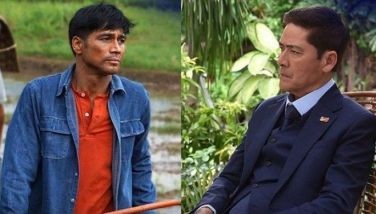Remembering the great Charito Solis
March 17, 2002 | 12:00am
Nine years before the late Charito Solis won her Asian Film Festival Award as Best Actress in 1967, she had already been up for best actress at the 1958 Asian Film Festival held in Kuala Lumpur. At that time, Malvarosa, produced by her home studio, LVN, was a Philippine entry, and Charito lost by a half point to Hong Kong’s Lin Dai who, unfortunately, died under mysterious circumstances about six years later. Rebecca del Rio, who portrayed Charito’s alcoholic mother in the movie written by Clodualdo del Mundo, Sr., bagged the Best Supporting Actress Award in the same Asian Filmfest.
Movies entered in the Asian Film festival are disqualified from the FAMAS derby especially when they are winners. If they were not, Charito could have won her first FAMAS Best Actress Award in 1958.
Fortunately, the two succeeding years were banner ones for Charito. In 1959, she got her first FAMAS Best Actress Award for her fine performance in Bert Avellana’s classic Kundiman ng Lahi. And in 1960, Charito won her second FAMAS for her tour de force acting in Emily under the tutelage of Gregorio Fernandez, the same megman who directed her in Malvarosa.
LVN was not a company that believed in spending heavily on promotions. For instance, it did not capitalize on the fact that, in 1960, Charito was the only actress to have bagged two FAMAS Best Actress Awards for two consecutive years. It could have been a perfect stepping stone in promoting Charito to the rank of the most popular actress at that time. Having been nominated for Best Actress at the 1958 Asian Filmfest, Charito actually found 1960 her third consecutive year of being a Best Actress nominee. It would have been another excellent publicity item for Charito’s growing acting talent then.
In 1963, Charito bagged two FAMAS nominations for Best Actress (in the same year): one, for her performance in Angustia which finally won for Charito her third FAMAS Award; and another, for her three-character portrayal in Tatlong Mukha ni Pandora which Charito considered her best performance among all her movies.
As documented by Nick Joaquin in a collection of his essays published in 1980, "Charito Solis won by ‘a runaway vote"’ for her difficult role in Angustia. The near-unanimous dacision among FAMAS members then to give Charito her third FAMAS Best Actress award was a glowing tribute to her acting prowess.
Nobody knew then that four years later, she became Asia’s Best Actress (a label the late Joe Quirino, as the Star Gazer, used to refer to her for many years thereafter.)
Charito’s development as an actress appears to have been hastened by having worked with a variety of directors. Novelist/scriptwriter Susana de Guzman discovered her crying capacity while directing Charito in Ulilang Bituin (for LVN, 1956). While doing a hospital scene where Charito, as a Korean war bride of a Filipino soldier (played by Mario Montenegro) realizes the near-tragic circumstances she has gone through, she cried so unabashedly that Director Susana de Guzman had to stop shooting the film until Charito regained her composure.
Before Charito’s stint in Kundiman ng Lahi with Bert Avellana, their first encounter was in one of the four episodes (entitled Welga) of the 1956 LVN anniversary film Medalyong Perlas where she portrayed Armando Goyena’s wife. In one emotional scene, Director Avellana could not be satisfied with Charito’s emoting and facial expression. During a break between takes, unknown to Charito, Bert signalled the camera to start grinding as he slapped her. The experience made the actress give the facial expression and the emotion Avellana wanted very much for the difficult sequence. She was then hailed as the new LVN dramatic find, barely one year after her very first starring role in Nina Bonita.
Her title role in Emily was initially publicized as a most daring role for an actress as young as Charito, for it called for her to perform the delivery of her baby in front of the camera. Charito had no qualms doing it under the fine direction of Gregorio Fernandez.
At that time, Charito had gradually made a name for doing things other actresses might turn their backs on. A year or two before, she did a very realistic rape scene for the movie Shakya (The Life of Guatama Budha), produced and shot entirely in Japan following the Japanese producer’s discovery of Charito’s fine acting at the 1958 Kuala Lumpur Asian Filmfest.
Movies entered in the Asian Film festival are disqualified from the FAMAS derby especially when they are winners. If they were not, Charito could have won her first FAMAS Best Actress Award in 1958.
Fortunately, the two succeeding years were banner ones for Charito. In 1959, she got her first FAMAS Best Actress Award for her fine performance in Bert Avellana’s classic Kundiman ng Lahi. And in 1960, Charito won her second FAMAS for her tour de force acting in Emily under the tutelage of Gregorio Fernandez, the same megman who directed her in Malvarosa.
LVN was not a company that believed in spending heavily on promotions. For instance, it did not capitalize on the fact that, in 1960, Charito was the only actress to have bagged two FAMAS Best Actress Awards for two consecutive years. It could have been a perfect stepping stone in promoting Charito to the rank of the most popular actress at that time. Having been nominated for Best Actress at the 1958 Asian Filmfest, Charito actually found 1960 her third consecutive year of being a Best Actress nominee. It would have been another excellent publicity item for Charito’s growing acting talent then.
In 1963, Charito bagged two FAMAS nominations for Best Actress (in the same year): one, for her performance in Angustia which finally won for Charito her third FAMAS Award; and another, for her three-character portrayal in Tatlong Mukha ni Pandora which Charito considered her best performance among all her movies.
As documented by Nick Joaquin in a collection of his essays published in 1980, "Charito Solis won by ‘a runaway vote"’ for her difficult role in Angustia. The near-unanimous dacision among FAMAS members then to give Charito her third FAMAS Best Actress award was a glowing tribute to her acting prowess.
Nobody knew then that four years later, she became Asia’s Best Actress (a label the late Joe Quirino, as the Star Gazer, used to refer to her for many years thereafter.)
Charito’s development as an actress appears to have been hastened by having worked with a variety of directors. Novelist/scriptwriter Susana de Guzman discovered her crying capacity while directing Charito in Ulilang Bituin (for LVN, 1956). While doing a hospital scene where Charito, as a Korean war bride of a Filipino soldier (played by Mario Montenegro) realizes the near-tragic circumstances she has gone through, she cried so unabashedly that Director Susana de Guzman had to stop shooting the film until Charito regained her composure.
Before Charito’s stint in Kundiman ng Lahi with Bert Avellana, their first encounter was in one of the four episodes (entitled Welga) of the 1956 LVN anniversary film Medalyong Perlas where she portrayed Armando Goyena’s wife. In one emotional scene, Director Avellana could not be satisfied with Charito’s emoting and facial expression. During a break between takes, unknown to Charito, Bert signalled the camera to start grinding as he slapped her. The experience made the actress give the facial expression and the emotion Avellana wanted very much for the difficult sequence. She was then hailed as the new LVN dramatic find, barely one year after her very first starring role in Nina Bonita.
Her title role in Emily was initially publicized as a most daring role for an actress as young as Charito, for it called for her to perform the delivery of her baby in front of the camera. Charito had no qualms doing it under the fine direction of Gregorio Fernandez.
At that time, Charito had gradually made a name for doing things other actresses might turn their backs on. A year or two before, she did a very realistic rape scene for the movie Shakya (The Life of Guatama Budha), produced and shot entirely in Japan following the Japanese producer’s discovery of Charito’s fine acting at the 1958 Kuala Lumpur Asian Filmfest.
BrandSpace Articles
<
>
- Latest
- Trending
Trending
Latest
Trending
Latest
Recommended

































